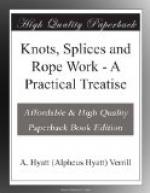[Illustration: FIG. 56.—Larks’ heads and running noose.]
[Illustration: FIG. 57.—Cleat and wharf ties.]
[Illustration: FIG. 58.—Bow-line.]
[Illustration: FIG. 59.—Tying bow-line.]
[Illustration: FIG. 60.—Bow-line on bight.]
[Illustration: FIG. 61.—Running bow-line.]
[Illustration: FIG. 62.—Loop knot.]
[Illustration: FIG. 63.—Loop knot.]
[Illustration: FIG. 64.—Loop knot.]
[Illustration: FIG. 65.—Loop knot.]
[Illustration: FIG. 66.—Tomfool knot.]
CHAPTER V
SHORTENINGS, GROMMETS, AND SELVAGEES
In many cases a rope may prove too long for our use or the free ends may be awkward, or in the way. At such times a knowledge of “shortenings” is valuable. There are quite a variety of these useful knots, nearly all of which are rather handsome and ornamental, in fact a number of them are in constant use aboard ship merely for ornament.
The simplest form of shortening, shown in Fig. 67, is a variation of the common and simple overhand knot already described and illustrated. These knots are formed by passing the end of a rope twice or more times through the loop of the simple knot and then drawing it tight (Fig. 68). They are known as “Double,” “Treble,” “Fourfold,” or “Sixfold” knots and are used to prevent a rope from passing through a ring or block as well as for shortening. All gradations from the double to the sixfold are shown in Fig. 69, both in process of making and as they appear when drawn taut. Another very simple form of shortening is shown in Fig. 70 and is known as the “Single Plait,” or “Chain Knot.” To make this shortening, make a running loop (A, Fig. 70), then draw a bight of the rope through this loop, as shown at B, draw another bight through this, as at C to D, and continue in this way until the rope is shortened to the desired length; the free end should then be fastened by passing a bit of stick through the last loop, F, or by running the free end through the last loop, as at E. To undo this shortening, it is only necessary to slip out the




